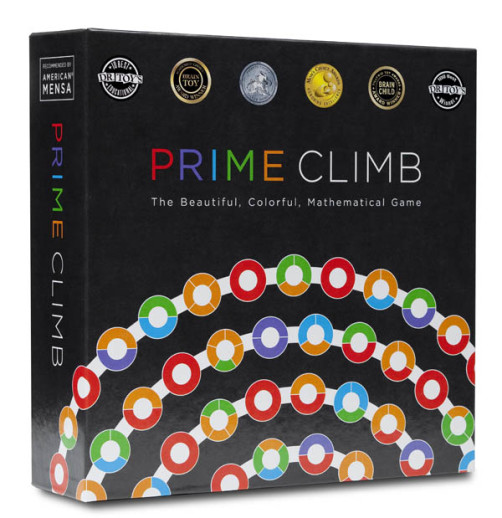We use cookies to make your experience better. To comply with the new e-Privacy directive, we need to ask for your consent to set the cookies. Learn more.
Prime Climb (Math 4 Love)
A teaching tool and a genuinely enjoyable math game in one beautiful package! The board consists of color-coded spaces from 1-101. Players try to reach 101 exactly with both pawns by adding, subtracting, multiplying, and dividing. Each turn, the active player rolls 2 10-sided dice, then uses each rolled number (one at a time) to perform an operation on the space their pawn is currently on. For example, if a player has 1 pawn on "14" and rolls a 7 and an 9, the player has 6 immediate options: subtract to 7 (14 - 7 = 7) or 5, add to 21 or 23, multiply to 98, or divide to 2.
And remember the color-coding I mentioned? It works for multiplication and division! The "14" space is half-orange, half-purple. The "7" space is all purple. So, the player adds the colors together and looks for the space with 2 purple parts and 1 orange part - "98!" Likewise, if the player chose to divide "14" by "7", they would simply subtract the "purple" color and look for the all-orange space. This provides a handy shortcut for those learning or reinforcing multiplication & division. Adding a final twist are "Action" and "Keeper" cards - when a pawn ends on a prime number above 10, they draw a card. Action cards are played immediately and allow players to switch pawns, roll again, or more. Keeper cards can be played any time during a player's turn with beneficial actions or to harm their opponent. The suggested age is 10+, but the only requirement to play is basic math skills. For 2-4 players. 45-minute playtime.
Winner of numerous awards, including the 2017 National Parenting Projects Award and Tillywig Toy Brain Child Award, and many others!
To play... Roll the dice and add, subtract, multiply and divide your way to the center of the board, picking up prime cards and bumping your opponents back to start as you go. Land both your pawns on 101 to win the game. Why choose Prime Climb? Prime Climb is a perfect game for families & schools, kids & adults.
Everyone can learn about prime numbers through play.
| Product Format: | Other |
|---|---|
| Brand: | Math For Love |
| Grades: | 3-AD |
| EAN/UPC: | 863002000108 |
| Length in Inches: | 10.125 |
| Width in Inches: | 10.125 |
| Height in Inches: | 2.875 |
| Weight in Pounds: | 1.7 |

